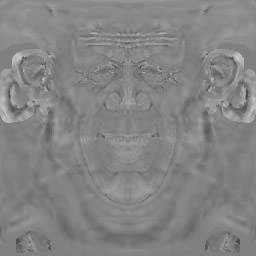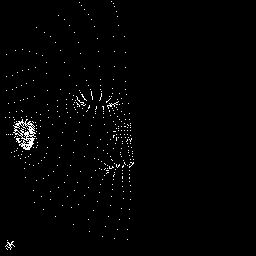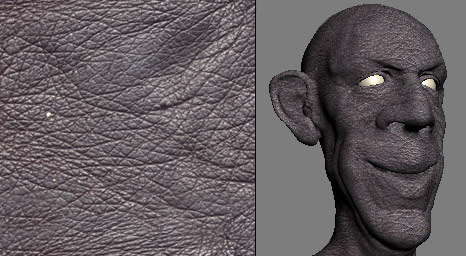This dialog provides a set of tools for creating bitmaps based on an object’s UVW mapping. The bitmaps display certain surface properties of the object. There’s also a Bitmap Select function for selecting sub-objects based on mapping attributes.
Also, the object must have a map channel (typically 1) corresponding to the current Map Channel setting on the Render Surface Map dialog. If the object has no map channel, an error message informs you of this fact. To provide a map channel, apply an Unwrap UVW or UVW Map modifier and then convert the object to an editable poly.
Procedure
Example: To use Render Surface Map:
- From the Rendering menu, choose Render Surface Map.
This opens the Render Surface Map dialog.
- Select the editable poly object for which to generate the surface map.
- Set the Map Channel parameter on the Render Surface Map dialog to that of the object. Attention: Make sure the object has a mapping channel and that Map Channel is set to that channel. If you attempt to render a surface map and encounter a message that says that the map channel does not exist, either set Map Channel to the correct value, or, if the object has no mapping, create mapping for it. To do so, apply a mapping modifier such as Unwrap UVW or UVW Map and then collapse the modifier stack.
Also, for best results, make sure mapping clusters do not overlap. For example, in the Unwrap UVW modifier, use the Flatten Mapping tool.
- Click one of the top four buttons on the Render Surface Map dialog: Cavity map, Density map, Dust map, or SubSurface map.
For example, to generate a texture that makes the object look dirty in concave areas, use Cavity Map.
After a brief pause, the generated texture opens in a separate window. The texture type (such as Cavity Map) appears in the window’s title bar.
- On the output window toolbar, click
 (Save Image). Specify a name, type (graphics format), and location for the file, and then click Save.
(Save Image). Specify a name, type (graphics format), and location for the file, and then click Save. - Use the Material Editor to assign the saved image file as a Diffuse map in a material, and then assign the material to the object you used to generate the map.
This procedure describes how to create a surface map and then use it in a material.
Interface

- W/H
- The width and height of the bitmap to generate. Tip: When generating bitmaps for use in real-time-rendering applications, such as games, both dimensions should be powers of 2, such as 256 or 512.
-
 Size
Size - Choose a size from the list of presets.
- Map Channel
- The map channel to use when generating the bitmap.
- Seam Bleed
- Determines how many pixels are added at UVW borders as “padding.” These bled pixels will never overwrite the pixels within UVW seams.
This value has no effect in SelectionToBitmap.
Bitmap Type
- Cavity Map
- Generate a grayscale image that displays how convex or concave the surface of an editable poly object is at a given point. The more concave the surface is the darker the pixels will be and the more convex the surface is the more white is added to the pixels.
This image can be used as a cavity or "dirt" map, or as a base for further texture painting.

A Cavity map created from a character head
- Contrast
- Determines how much extra contrast is added. In a very high resolution mesh the surface does not change much from polygon to polygon, so in such cases it might be neccessary to increase the contrast to get the difference in concavity/convexity to show clearly.
- Density Map
- Generates a grayscale image that displays how dense the editable poly mesh is at a given point. White areas represent the smallest distance between vertices and black represents the greatest distance.

A Density map created from a character head
- Dust Map
- Generates a grayscale image that the extent to which each point in the surface faces the world Z direction. White represents vertices pointing fully in the Z direction and black represents vertices pointing 90 degrees from the Z axis (that is, parallel to the world XY plane) or below.

A Dust map created from a character head
- SubSurface Map
- Generates a grayscale image that displays an estimation of the relative volume of a poly object at a given point. White represents the thinnest parts and black represents the thickest parts. You can then use this map to simulate greater translucency in thin areas.
The resulting map does not necessarily represent accurately how light would pass through the surface but can be useful for simulating this.

SubSurface maps created from a poly mesh, showing different Blur values
The upper two images use flat shading so that only the texture is visible.
- Blur
- The degree of blurring applied to the generated map.
In the preceding illustration, the top rendering has Blur set to 4, while the center one has Blur set to 40. The bottom rendering shows the poly object without a texture map.
- Occlusion Map
- Generates a grayscale bitmap based on the extent to which parts of the object occlude other parts. Does not depend on scene lighting.
- SelectionToBitmap
- Generates a black-and-white bitmap based on the current sub-object selection and displays it in a window from which you can save it.
White areas in the output image indicate selected sub-objects at that location. At the vertex level each vertex gets a white dot. At the edge level each edge gets a dot in the middle of the edge. At the polygon level each polygon is filled with white color.
You can use a bitmap generated with SelectionToBitmap for selecting sub-objects with the Bitmap Select tool (see following).

SelectionToBitmap used at the Vertex level
Note: You can assign CUI shortcuts (PolyTools category) for SelectionToBitmap. When assigned as shortcuts, the image is generated as follows:- Normal (no key) Creates a 256x256 bitmap.
 Creates a 512x512 bitmap.
Creates a 512x512 bitmap.
Texture Wrap
This tool creates a texture map from an input texture and wraps it around the selected object in a way that creates no texture seams and with a uniform texture scale across the surface. It projects the input texture from all directions and blends the result based on surface normal. A good use for this tool is to provide a base texture for a model. For example, you can create a basic skin texture and wrap that around the whole character model in a seamless way. Another use is for complex shapes such as a tree and all its branches.
To use Texture Wrap, first click Pick Texture to specify a texture file, then select the object to wrap and click Texture Wrap.

The input texture (left) and the resulting wrapped texture applied to a model (right)
- Pick Texture
-
Opens a file dialog for specifying an image file to wrap as the texture.
- Tile
-
The number of times the texture will be repeated across the object, both horizontally and vertically.
- Texture Wrap
-
With an editable poly object selected, click to wrap the texture.
- Bitmap Select
-
Opens the Bitmap Select dialog, which lets you select parts of the model based on a bitmap image.